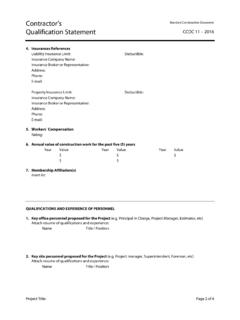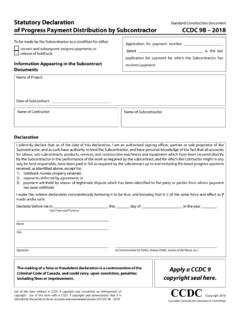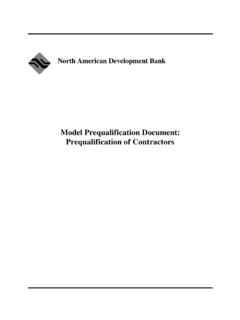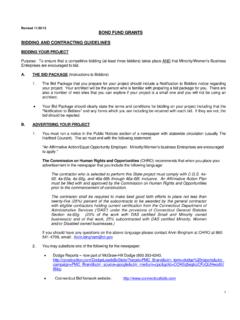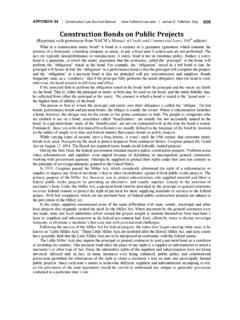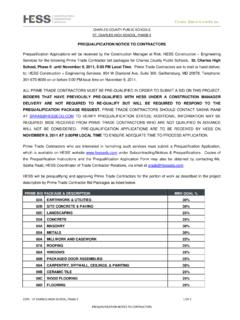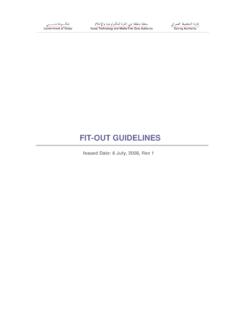Transcription of Bulletin 17 - CCDC
1 75 Albert Street Suite 400. Ottawa, Ont. K1P 5E7. Tel: (613) 236 -9455. Fax: (613) 236-9526. Bulletin 17. CONSTRUCTION WARRANTIES. November 1998. Introduction In recent years warranties have been the subject of much concern. More often than not, the discussion focuses on the complexities of specifying extended Product and system warranties. This Bulletin provides a brief explanation of the main types of warranties and an overview of the points to consider when specifying extended warranties. Purpose A construction warranty: protects the Owner against defects or failures within the warranty period.
2 Provides a remedy to the O wner for non-conformance with the Contract discovered prior to or after Substantial Performance of the Work ;. gives the O wner recourse against other parties ( manufacturers, subcontractors, and suppliers) who may not be in a direct contractual relationship with the O wner but who provide extended warranties directly;. and defines the responsibilities of all parties regarding the coverage of the warranty. Construction Warranties Association of Consulting The overall warranty period for the Work under CCDC contracts is one year from the Engineers date of Substantial Performance of the Work.
3 The Contractor is responsible to correct at of Canada his/her own expense, defects or deficiencies in the Work which appear during the one- year warranty period. Warranties for longer than one year ( extended warranties) may be specified for Canadian certain Products (Product warranties) or portions of Work (system warranties) in the Construction specification sections of the Contract Documents. Association Extended warranties are typically of two types: Product warranties covering replacement of the Product; and System warranties covering replacement of the Product and the entire Construction installation ( roofing systems, glazing systems, mechanical or electrical Specifications systems).
4 Canada The Royal Architectural Institute of Canada Page 2 of 3 Bulletin 17. Extended Product Warranties Extended warranties for the replacement of Products offered by product manufacturers usually only cover the Product, not the transportation, removal of the failed Product, reinstallation of its replacement or any associated labour costs. For example, a carpet manufacturer may warrant that its product will not zipper or edge ravel for a period of 10. years from date of installation. If this carpet fails to perform as warranted, the manufacturer's responsibility is usually limited to the supply of replacement product and will not include the removal of the existing carpet, installation of the new carpet or such incidental costs as moving of furniture.
5 CCDC contracts stipulate that the Contractor's responsibility with regard to extended Product warranties is limited to obtaining the extended warranty documentation on the O wner's behalf from the manufacturer or supplier (warrantor). The extended Product warranty documentation is to be issued by the manufacturer or supplier to the benefit of the Owner. Extended System Warranties Extended system warranties cover the supply and installation of a component or group of components. These extended warranties are normally offered by manufacturers and cover components typically installed by a Subcontractor approved by the manufacturer.
6 Extended system warranties usually contain restrictive provisions which significantly limit the warrantor's liability and the O wner's recourse in the event of a failure. For example, a manufacturer's inverted roof system warranty may cover the cost of repairing leaks which occur as a result of defects in their roof system components or defects in installation for a period of 5 years from the date of Substantial Performance. Should a leak develop in the system, the manufacturer's responsibility normally would not include the costs for removal and reinstallation of roof top landscaping materials or the costs associated with repair of interior finishes damaged as a result of the roof leak.
7 The warranty could require the payment of a fee by the O wner and may state that any claims under the terms of the warranty be made within a very restrictive time period. As with extended Product warranties, extended system warranties are obtained by the Contractor from the warrantor and issued by the warrantor to the benefit of the Owner. Benefits There are immediate benefits that can be gained from an equitable extended warranty that may make it worth the extra cost to the Owner. These benefits include the prequalification of the installer by the manufacturer, the manufacturer's involvement in the construction process, and the extended protection against failure.
8 For the extended warranties to be effective, the warrantor must be financially secure to cover its potential liability. Page 3 of 3 Bulletin 17. Limitations Extended warranties are not all-inclusive insurance policies designed to cover any problem regardless of circumstance. Since these warranties are normally written by the manufacturer, from the manufacturer's perspective, they invariably contain language that limits the scope of coverage. Extended warranties usually exclude consequential and incidental damage to any building component other than the warranted Product or system itself.
9 Even the most comprehensive extended warranties that cover material and workmanship, generally provide that the warrantor will only repair faults that result from specific causes enumerated in the warranty. Warranties should be carefully read to determine exactly what is covered and what is excluded. The exclusions and limitations are very important. Specifying Extended Warranties The C onsultant should be familiar with standard warranties offered for specified Products and systems as well as the physical qualities and performance characteristics of the products.
10 The size, stability and reputation of the manufacturer and its ability to make good on a warranty claim may be more important than the terms of the warranty itself. When specifying warranties the Consultant should avoid: relying on a warranty as a substitute for a thorough investigation of a Product or system and an assessment of its manufacturer; and requiring warranty coverage that is not available for a particular Product or system. The Consultant should determine before producing the specifications: whether extended warranties are offered or available.

